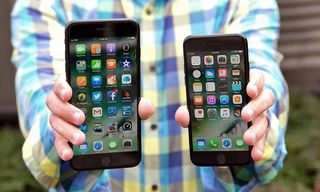What Record-Breaking iPhone 7 Plus Signals About 8
The success of the iPhone 7 Plus shows that shoppers are willing to pay more for extra features, and the iPhone 8 will likely build on that momentum.
Did you think the iPhone 7 was a dull update that didn't do enough to distinguish itself from the iPhone 6s? The market respectfully disagrees with you.
Apple says it sold a record number of iPhones during the holiday quarter. And that success — particularly with the iPhone 7 Plus — could push Apple to pack more features into its higher-end models like the iPhone 8.

Announcing earnings for its fiscal first quarter today (Jan. 31), Apple said it sold nearly 78.3 million iPhones in the three-month period ending Dec. 31, 2016. That's the most iPhones Apple has ever sold in a quarter, and a 5-percent jump over the year-ago quarter. iPhones brought in a little less than $54.4 billion in revenue — another quarterly record — which made up 69 percent of Apple's total quarterly revenue of $78.4 billion.
MORE: Get Ready for iPhone 8 Ferrari: New Model Leaked
The interesting story, though, was the success enjoyed by the iPhone 7 Plus. Apple never breaks out sales by model in its product lines. But CEO Tim Cook did specifically call out the 5.5-inch phone when touting the company's successes to Wall Street analysts. The iPhone 7 remains the more popular of the two iPhones, Cook said, but the 7 Plus enjoyed the highest percentage of sales for Plus models since Apple introduced the bigger screen version of its phone.
"It's the most popular Plus model we've ever had," Cook said.
Apple didn't dive into the reasons for that popularity, but it's pretty easy to argue that the iPhone 7 Plus did more to differentiate itself from its smaller sibling than any Plus-sized iPhone before it. Rather than just tout a larger screen, the 7 Plus also features a dual rear camera that really sets it apart from the iPhone 7. When Tom's Guide reviewed the two iPhone 7 models last fall, in fact, we recommended the iPhone 7 Plus over the iPhone largely on the strength of that dual-lens camera.
The popularity of the iPhone 7 Plus was noteworthy for another reason: It had the most expensive starting price of any iPhone Apple's ever sold. At $769, the 7 Plus cost $120 more than the starting price for the iPhone 7; previously Plus models only cost $100 more than their smaller counterparts.
No one knows for certain what lessons Apple will take away from its quarterly numbers. But given the demand for the iPhone 7 Plus — it was only this month that Apple finally reached a balance between supply and demand for the 5.5-inch model — it's easy to conclude that iPhone fans are willing to pay up for a smartphone if it has features that justify the extra cost.
MORE: iPhone 7 Plus vs Galaxy S7 Camera Shootout
Sign up to get the BEST of Tom’s Guide direct to your inbox.
Upgrade your life with a daily dose of the biggest tech news, lifestyle hacks and our curated analysis. Be the first to know about cutting-edge gadgets and the hottest deals.
And that could inform the decisions Apple is making about its next smartphone. While Apple has remained mum about its smartphone plans, rumors about this fall's expected iPhone release suggest that Apple could add a third iPhone model in 2017. Under this rumor, Apple would make modest changes to its 4.7- and 5.5-inch phones — perhaps even calling them the iPhone 7s and 7s Plus — while coming out with an iPhone 8 that offers more substantial improvements.
Among the rumored features there include an OLED screen (which would be an upgrade over the iPhone's current LCD panels), an edge-to-edge design that all but eliminates the phone's bezel and wireless charging. Some of the more fanciful speculation about the iPhone 8 suggests it could feature a 5.8-inch screen and adopt the Smart Connector currently limited to Apple's iPad Pro.
A phone with those kind of features would command a higher price than what you would currently pay for an iPhone. But Apple's quarterly iPhone sales just indicated that Apple's customers won't mind if those features are compelling enough.
Whatever Apple has planned, Cook made it clear to Wall Street analysts in today's call, that the iPhone remains a major part of Apple's plans. (You'd say that, too, if one product accounted for more than two-thirds of your sales.) Cook specifically cited the smart home integration added in iOS 10 — the Apple CEO has set up Siri to turn on his lights and start his coffee pot brewing when he gets up in the morning — and Apple's CarPlay platform as areas where the iPhone still has room to grow.
"I think the smartphone is still in the early innings of the game," Cook said. "There are still more things it can do."
Philip Michaels is a Managing Editor at Tom's Guide. He's been covering personal technology since 1999 and was in the building when Steve Jobs showed off the iPhone for the first time. He's been evaluating smartphones since that first iPhone debuted in 2007, and he's been following phone carriers and smartphone plans since 2015. He has strong opinions about Apple, the Oakland Athletics, old movies and proper butchery techniques. Follow him at @PhilipMichaels.

